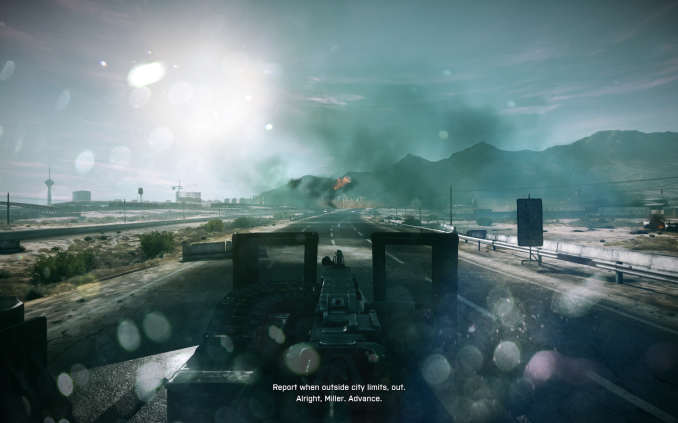Intel Iris Pro 5200 Graphics Review: Core i7-4950HQ Tested
by Anand Lal Shimpi on June 1, 2013 10:01 AM ESTImage Quality
Software compatibility and image quality remain understandable concerns, however Intel has improved tremendously in these areas over the past couple of years. I couldn't run Total War: Shogun 2 on Iris Pro, but other than that every other game I threw at the system ran without errors - a significant improvement over where things were not too long ago. On the compute side, I couldn't get our Folding@Home benchmark to work but otherwise everything else ran well.
On the image quality front I didn't see too much to be concerned about. I noticed some occasional texture flashing in Battlefield 3, but it was never something I was able to grab a screenshot of quickly enough. Intel seems pretty quick about addressing any issues that crop up and as a company it has considerably increased staffing/resources on the driver validation front.
The gallery below has a series of images taken from some of the benchmarks in our suite. I didn't notice any obvious differences between Intel and NVIDIA render quality. By virtue of experience and focus I expect software compatiblity, image quality and driver/hardware efficiency to be better on the NVIDIA side of the fence. At the same time, I have no reason to believe that Intel isn't serious about continuing to address those areas going forward. Intel as a company has gone from begging software developers to at least let their code run on Intel integrated graphics, to actively working with game developers to introduce new features and rendering techniques.

















177 Comments
View All Comments
s2z.domain@gmail.com - Friday, February 21, 2014 - link
I wonder where this is going. Yes the multi core and cache on hand and graphics may be goody, ta.But human interaction in actual products?
I weigh in at 46kg but think nothing of running with a Bergen/burden of 20kg so a big heavy laptop with ingratiated 10hr battery and 18.3" would be efficacious.
What is all this current affinity with small screens?
I could barely discern the vignette of the feathers of a water fowl at no more than 130m yesterday, morning run in the Clyde Valley woodlands.
For the "laptop", > 17" screen, desktop 2*27", all discernible pixels, every one of them to be a prisoner. 4 core or 8 core and I bore the poor little devils with my incompetence with DSP and the Julia language. And spice etc.
P.S. Can still average 11mph @ 50+ years of age. Some things one does wish to change. And thanks to the Jackdaws yesterday morning whilst I was fertilizing a Douglas Fir, took the boredom out of a another wise perilous predicament.
johncaldwell - Wednesday, March 26, 2014 - link
Hello,Look, 99% of all the comments here are out of my league. Could you answer a question for me please? I use an open source 3d computer animation and modeling program called Blender3d. The users of this program say that the GTX 650 is the best GPU for this program, siting that it works best for calculating cpu intensive tasks such as rendering with HDR and fluids and other particle effects, and they say that other cards that work great for gaming and video fall short for that program. Could you tell me how this Intel Iris Pro would do in a case such as this? Would your test made here be relevant to this case?
jadhav333 - Friday, July 11, 2014 - link
Same here johncaldwell. I would like to know the same.I am a Blender 3d user and work on cycles render which also uses the GPU to process its renders. I am planning to invest in a new workstation.. either a custome built hardware for a linux box or the latest Macbook Pro from Apple. In case of latter, how useful will it be, in terms of performance for GPU rendering on Blender.
Anyone care to comment on this, please.
HunkoAmazio - Monday, May 26, 2014 - link
Wow I cant believe I understood this, My computer archieture class paid off... except I got lost when they were talking about n1 n2 nodes.... that must have been a post 2005 feature in CPU N bridge S Bridge TechnologysystemBuilder - Tuesday, August 5, 2014 - link
I don't think you understand the difference between DRAM circuitry and arithmetic circuitry. A DRAM foundry process is tuned for high capacitance so that the memory lasts longer before refresh. High capacitance is DEATH to high-speed circuitry for arithmetic execution, that circuitry is tuned for very low capacitance, ergo, tuned for speed. By using DRAM instead of SRAM (which could have been built on-chip with low-capacitance foundry processes), Intel enlarged the cache by 4x+, since an SRAM cell is about 4x+ larger than a DRAM cell.Fingalad - Friday, September 12, 2014 - link
CHEAP SLI! They should make a cheap IRIS pro graphics card and do a new board where you can add that board for SLI.P39Airacobra - Thursday, January 8, 2015 - link
Not a bad GPU at all, On a small laptop screen you can game just fine, But it should be paired with a lower CPU, And the i3, i5, i7 should have Nvidia or AMD solutions.